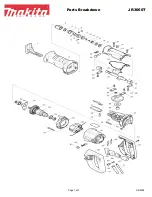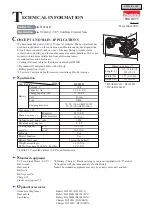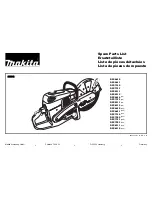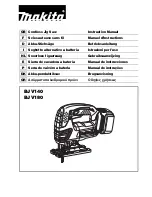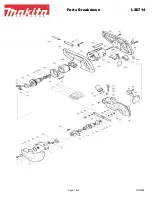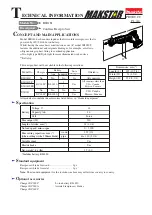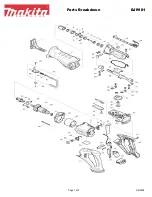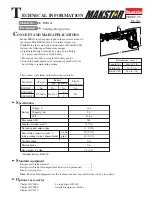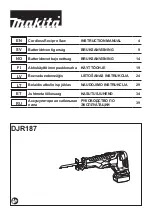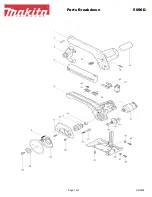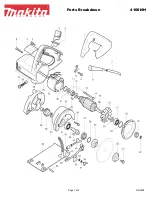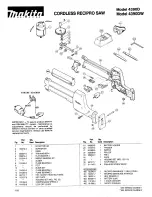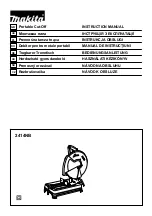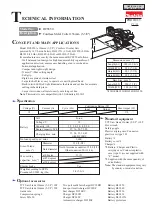
28 ENGLISH
Special Max Width Cutting
Capacities Technique
The maximum width cutting capacity of this tool can be
achieved by following the steps below:
For the maximum cutting width of this tool refer to the
!G>>G#">:? G
cuttings".
1.
Set the tool at 0° or 45° miter angle and make sure
that the turn base is locked. (Refer to the section titled
# Q
2.
Remove both right and left upper fences temporar-
ily and set aside.
3.
Cut a platform to the dimensions indicated in the
[A@A
wood, plywood or particle board.
j
Fig.55:
1.
0° Miter angle: Over 450 mm
2.
45° Miter
angle: Over 325 mm
3.
38 mm
4.
Over
760 mm
WARNING:
&)y<()]Y<y)#]y]Y\$#y#
platform.
A@
cutting operation which may result in kickback and
NOTE:
The maximum cutting capacity in height will
be reduced by the same amount as the platform
thickness.
4.
Place the platform on the tool so that it extends
equally over each side of the tool base.
Secure the platform to the tool using four 6 mm wood
screws through four holes in the lower fences.
j
Fig.56:
1.
Screws (two each side)
2.
Lower fence
3.
Base
4.
Platform
WARNING:
#$)y<()] #]] )X%#][Y(j'y%#:-
'.^#]#^#'.y]]
)]YY%;#y)#.y)\<()(j%:
to the lower fences using the four screw holes
provided.
Failure to properly secure the platform may
result in movement and possible kickback resulting in
WARNING:
}.y<()] #]] )]YY%'y(j%:
jY<.])]Y#y]#;%)#.#]y<([#\)
Failure to
properly mount and secure the tool could cause the
tool to be unstable resulting in a loss of control and/
or the tool falling which may result in serious personal
5.
Install the upper fences on the tool.
WARNING:
Do not use the tool without upper
fences installed.
The upper fences provide the ade-
quate support required to cut the workpiece.
If the workpiece is not supported properly, it may
move resulting in possible loss of control, kickback
6.
Place the workpiece to be cut on the platform
secured to the tool.
7.
J A
fences with a vise before cutting.
j
Fig.57:
1.
Upper fence
2.
Vertical vise
3.
Workpiece
4.
Platform
8.
Make a cut through the workpiece slowly accord-
ing to the operation titled "Slide (push) cutting (cutting
wide workpieces)."
WARNING:
Ensure that the workpiece is
y)\<()|'] ] )'y)#.j#$)] )\<]y%Y|%:
Failure to do so may cause the workpiece to move
resulting in possible kickback and serious personal
WARNING:
&)#|#()] #]] )X%#][Y(jj#:
become weakened after several cuts are per-
formed at various miter angles.
If the platform
becomes weakened due to the multiple kerf cuts left
in the material, the platform should be replaced. If the
weakened platform is not replaced, it may cause the
workpiece to move, during cutting, resulting in possi-
AAA
_#((:'.^]YY%
Before carrying, make sure to unplug and all movable
J #JA
following:
"
" %}
secured.
" J A
"
locked.
" -
tion and secured.
"
Carry the tool by holding both sides of the tool base as
J
j
Fig.58
WARNING:
Stopper pin for carriage elevation
'y[Y(\#((:'.^#.y]Y(#^)X<(XYy)yY.%:#..Y]
[Y(#.:\<]]'.^YX)(#]'Y.y
The use of the stopper
pin for cutting operations may cause unexpected
movement of the saw blade resulting in kickback and
CAUTION:
%|#:yy)\<()#%%jY'.^XY(]'Y.y
;)[Y()\#((:'.^] )]YY%
If portions of the tool move
or slide while being carried, loss of control or balance
MAINTENANCE
WARNING:
%|#:y;)y<()] #]] )]YY%'y
switched off and unplugged before attempting
to perform inspection or maintenance.
Failure to
unplug and switch off the tool may result in accidental
start up of the tool which may result in serious per-
WARNING:
%|#:y;)y<()] #]] );%#)'y
sharp and clean for the best and safest perfor-
mance.
#J'
may cause kickback and result in a serious personal
Summary of Contents for LS1219
Page 2: ...Fig 1 10 11 12 14 15 3 2 4 5 8 7 9 13 6 1 16 17 18 19 20 21 Fig 2 2 ...
Page 3: ...7 8 5 6 1 2 3 4 9 10 11 15 13 12 14 Fig 3 1 2 Fig 4 1 3 2 4 Fig 5 3 ...
Page 4: ...1 3 2 Fig 6 1 Fig 7 1 Fig 8 3 1 2 Fig 9 1 Fig 10 1 2 3 4 6 5 Fig 11 4 ...
Page 5: ...1 Fig 12 1 Fig 13 1 3 2 Fig 14 1 2 Fig 15 1 3 2 4 Fig 16 1 Fig 17 5 ...
Page 6: ...1 Fig 18 1 2 Fig 19 1 Fig 20 1 Fig 21 1 Fig 22 3 2 1 Fig 23 1 2 3 Fig 24 6 ...
Page 7: ...1 Fig 25 1 Fig 26 A B Fig 27 1 Fig 28 3 1 2 Fig 29 7 ...
Page 8: ...3 1 2 Fig 30 2 3 1 4 5 Fig 31 1 2 Fig 32 1 2 3 4 5 6 Fig 33 3 1 2 Fig 34 8 ...
Page 9: ...1 2 Fig 35 1 Fig 36 1 2 Fig 37 1 2 4 3 2 1 3 4 Fig 38 2 3 1 Fig 39 1 2 3 4 Fig 40 9 ...
Page 10: ...1 2 3 Fig 41 2 1 Fig 42 1 Fig 43 1 Fig 44 Fig 45 10 ...
Page 11: ...1 2 3 Fig 46 1 2 3 Fig 47 2 3 1 4 Fig 48 1 2 3 4 Fig 49 1 4 2 3 Fig 50 2 1 Fig 51 11 ...
Page 13: ...1 Fig 60 2 1 Fig 61 1 2 3 Fig 62 Fig 63 1 2 Fig 64 13 ...
Page 14: ...4 5 1 3 2 Fig 65 1 4 2 3 5 Fig 66 1 2 Fig 67 1 Fig 68 1 Fig 69 14 ...































